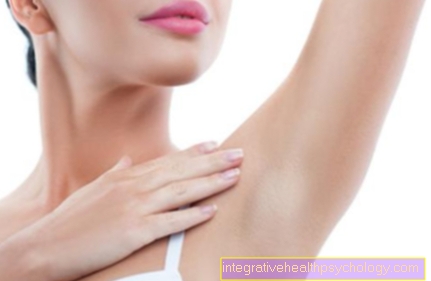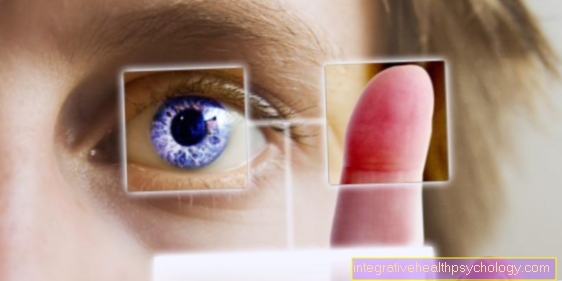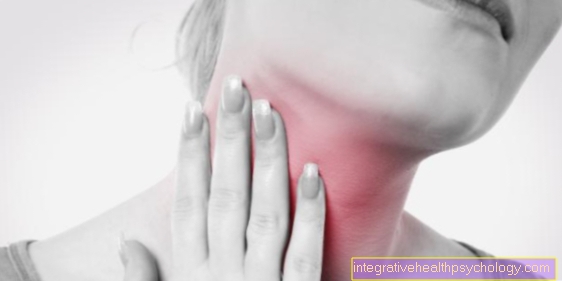Neurodermatitis in the crook of the arm
introduction
Neurodermatitis in the crook of the arm, also known as atopic eczema, is a skin disease.
It is characterized by the recurring occurrence of strongly itchy, sometimes oozing, eczema spots in the crook of the arm and permanently dry, rather rough skin. The condition is most common in children under 5 years of age.

Causes of atopic dermatitis in the crook of the arm
A combination of different factors is responsible for the occurrence of neurodermatitis in the crook of the arm.
On the one hand, a hereditary predisposition plays a role: children of parents who suffer from neurodermatitis themselves or who suffered in childhood have an increased risk of developing neurodermatitis as well.
In addition to neurodermatitis symptoms in the crook of the arm, there are also other diseases such as hay fever or asthma, which is referred to as atopic diseases.
In some children, atopic dermatitis, which often shows up in the crook of the arm, is triggered by allergies to certain foods. These include cow's milk, fish, soy, eggs, nuts or wheat. Other allergies, for example to animal hair or house dust mites, increase the risk of developing neurodermatitis.
If neurodermatitis already exists, its occurrence can be triggered by certain factors. For example, through allergen contact, skin contact with wool fibers, drying out of the skin and sweating.
In addition, various foods can make the atopic dermatitis bloom in the crook of the arm. These include tomatoes and strawberries. Shower detergents and detergents can also trigger an atopic dermatitis attack.
stress
It is not for nothing that atopic eczema is also called neurodermatitis. Psychological factors are not the cause of the disease, but if the disease is present, they can promote the occurrence of acute neurodermatitis attacks in the crook of the arm.
Mental stress in particular is one of the possible triggers of an acute attack. The exact pathophysiological mechanisms have not yet been clarified.
What are the other consequences of stress? Our next article could also be of interest to you: Consequences of stress
This is how the diagnosis is made
In order to be able to diagnose neurodermatitis, no special tests are usually required. Often the skin findings, in this case the crook of the arm, are a relatively reliable indication of the presence of the disease.
The crook of the arm is a very typical location for neurodermatitis, especially in childhood. The skin is often rough and dry on other parts of the body as well. The family history also provides further clues to the diagnosis. Often parents, grandparents or siblings are also affected.
Concomitant symptoms
If there is atopic dermatitis in the crook of the arm, various accompanying symptoms can occur. Often times, only a little rough and rather dry skin is noticeable. If there is an acute flare-up of neurodermatitis, reddish foci of eczema develop.
With a chronic course they can be dry and scaly, but in the acute stage they often show up with swellings and blisters. It is not uncommon for eczema to get wet in the acute phase.
Atopic dermatitis in the crook of the arm is often accompanied by pronounced and agonizing itching. The increased scratching caused by the itching leads to a worsening of the skin condition.
In addition to neurodermatitis, other atopic diseases can be present. With asthma, attacks of breathlessness and coughing occur. With hay fever, the eyes itch and water and the nose runny during the pollen season.
Treatment of neurodermatitis in the crook of the arm
The treatment of neurodermatitis in the crook of the arm is usually a long-term therapy that must be carried out regularly. The basic therapy with moisturizing and fatty creams that must be applied at least once a day is crucial.
In the acute stage, it may also be necessary to use cortisone preparations in the form of ointments. Ointments containing cortisone should always be used as briefly as possible due to their possible side effects if used over a longer period.
In recent years, ointments containing so-called immunomodulators have proven to be a further therapeutic option for severe neurodermatitis in the crook of the arm that does not respond adequately to cortisone preparations. In the case of bacterial colonization in severe neurodermatitis (bacterial superinfection), the use of local antibiotics may be necessary.
In addition to the measures mentioned, there are general measures intended to avoid possible triggers of acute attacks as much as possible. This includes avoiding clothing materials that can trigger an atopic dermatitis flare-up, as well as avoiding potentially triggering foods. The substances and foods that can be used vary greatly from person to person and are based on empirical values and precise observation.
Air that is too dry and smoking indoors should also be avoided.Restrictive contact with pets may be necessary for susceptible children and adults. Fabric softeners and soaps should be avoided. PH-neutral washing emulsions are ideal for body care.
Are you interested in this topic? Read more about this under: Treatment of neurodermatitis
These creams can help
For basic care, moisturizing, moisturizing creams containing glycerine or urea should be used. There are many different creams that differ in composition and fat content. It is often necessary to try out individually which base cream achieves the best effect.
Ointments containing cortisone often have to be used in the acute episode. Frequently used active ingredients are mometasone, methylprednisolone and hydrocortisone.
If no adequate effect can be observed with ointments containing cortisone, drugs from the group of calcineurin inhibitors in ointment form have also been used in recent years. The preparations used here are tacrolimus and pimecrolimus. The ointments are applied thinly to the affected skin areas 1-2 times a day.
Would you like to read more about this? You can find detailed information at: These creams can help with atopic dermatitis or cortisone for neurodermatitis
These home remedies are there
The application of cold can help relieve the itching. Either in the form of ice packs wrapped in a cloth or with the help of cold, damp cloths that are placed on the eczema in the crook of the arm.
Table salt compresses can also have a soothing effect. Either saline solution from the pharmacy (0.9%) or home-made saline solution (9 grams of table salt per 11 liters of boiled water) can be used for this. Clean cotton rags or towels or compresses can then be soaked in the saline solution and placed on the crook of the arm or wrapped around it. The skin should then be provided with a base cream.
In the case of heavily weeping eczema, compresses of table salt often lead to a painful burning sensation; black tea compresses can be beneficial here. To do this, brew very strong black tea and let it cool down. Then soak the cloths or compresses in it and place them on the neurodermatitis areas in the crook of your arm and leave for about 10-15 minutes.
You can find detailed information on this topic at: Home remedies for atopic dermatitis
forecast
Atopic dermatitis in the crook of the arm occurs mainly in babies and toddlers. In many cases the skin will improve significantly by the time you reach school. Atopic dermatitis of the crook of the arm is rather rare, even in older children or adults.
As long as the disease persists, it usually progresses in phases. Patients who have suffered from neurodermatitis in previous years tend to have dry skin for the rest of their lives that requires regular care.
For a few tips on how to fight dry skin, see our next article at: Skin care for atopic dermatitis
Recommendation from the editorial team:
- Atopic dermatitis flare-up
- Home remedies for dry skin
- Diet for atopic dermatitis





























